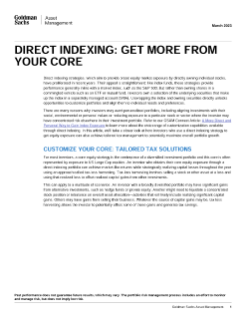It's What You Keep That Counts
Source: Goldman Sachs Asset Management. All data is as of June 30, 2025 unless otherwise specified. There is no guarantee that these objectives will be met. Goldman Sachs does not provide accounting, tax or legal advice. Please see additional disclosures at the end of this presentation. Vintage composites are grouped by the year the accounts funded because the ability to generate realized capital losses is influenced by market conditions. For example, the 2015 Vintage Composite contains all accounts that incepted in 2015. Past performance does not guarantee future results, which may vary. Assets Under Supervision (AUS) includes assets under management and other client assets for which Goldman Sachs does not have full discretion.
Tax costs can significantly erode investment returns. Our tax-advantaged equity strategies aim to help you keep more of what you earn.
We aim to provide market-like returns through direct indexing, by purchasing a portfolio of stocks that is similar to a broad market index.
Our broad range of tax management capabilities can potentially help investors keep more of what they earn throughout the lifetime of their investment.
By keeping more invested in the market through tax deferral, investors can benefit from compounding growth to build more wealth.

Learn more about tax-loss harvesting strategies and how they work?
Direct indexing aims to mimic the performance of an index by directly buying individual securities, rather than purchasing an exchange-traded fund or mutual fund.
Tax drag refers to a loss in returns on an investment or portfolio due to the long-term impact of taxes.
Paying taxes on capital gains can significantly erode the value of a portfolio, leaving less to grow and compound over time.
The minimum investment for this strategy is $250,000.
Core equity refers to an investing methodology that exposes investors to a diverse range of US companies.
Tax-loss harvesting is the process of selling securities to realize capital losses and replacing them with similar securities under certain constraints. The realized capital losses can be used to offset capital gains, reducing taxes paid, and enhancing after-tax returns.





